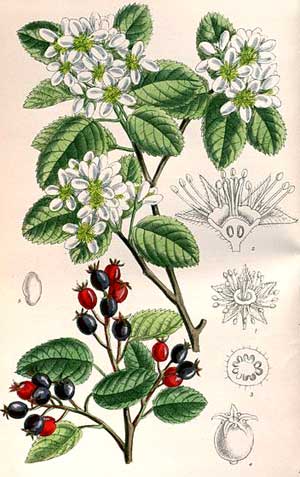Plant Portrait - Amelanchier alnifolia Juneberry
 There are many different species of juneberries, and they all produce more or less edible fruits - though some are certainly more desirable than others. Perhaps the most exciting is the saskatoon, Amelanchier alnifolia. This is one of the smaller- growing members of the genus, forming a deciduous shrub that seldom exceeds 3 metres in height and occasionally suckering to form a slowly spreading clump.
There are many different species of juneberries, and they all produce more or less edible fruits - though some are certainly more desirable than others. Perhaps the most exciting is the saskatoon, Amelanchier alnifolia. This is one of the smaller- growing members of the genus, forming a deciduous shrub that seldom exceeds 3 metres in height and occasionally suckering to form a slowly spreading clump.
An easily grown plant, it prefers a rich loamy soil and thrives in any soil that is not too dry or water-logged. The largest yields, and best quality fruits, are produced when the plant is grown in a sunny position, though it should also do reasonably well in semi-shade. The plants are fairly lime tolerant and they will also grow well in heavy clay soils. They are very cold-hardy and will tolerate temperatures down to at least -20°c and probably much lower.
Juneberries first make us aware of their presence in the garden in early to mid-spring when they come into flower. These white flowers are produced before the plants come into leaf, and are usually produced so abundantly that the whole plant turns white. They look particularly beautiful at this time. By late June, or more commonly early to mid July, the plants will usually be carrying large crops of fruits. These fruits are about 15mm in diameter, they are soft, sweet and juicy with a taste that reminds us of apples. There are usually 2 - 5 seeds contained in an apple-like core at the centre of the fruit, these are small enough to be eaten without problems, though they can add a slightly bitter almond-like flavour to the fruit if they are crushed whilst eating. We have found very few people who do not enjoy eating these fruits raw - it is more a problem of finding enough fruit to supply all the clamouring mouths! The fruit can also be cooked in pies etc., when dried it is quite sweet and can be used in the same ways as raisins. The main draw-back we have found to producing fruit in this genus is that birds adore the fruit at least as much as we do and will often completely strip a plant before the fruit is fully ripe. At least this particular species is small enough to make it practical to protect the fruit from the ravages of the birds.
Come the autumn, and the plant once more makes its presence felt in the garden as the leaves take on lovely yellow and red shades of autumn colour before falling.
Juneberries are very easy to propagate and seed is the simplest method if this can be obtained. It is best sown as soon as it is ripe in the summer, and should then germinate in late winter. Stored seed can be a bit slow to germinate - don't give up on it for at least 18 months. The main problem of growing from seed is that you can never be sure of the quality of your seedling plants. Juneberries are very promiscuous creatures and will readily cross-pollinate with other juneberry species growing nearby. Unless you want to experiment with producing superior fruiting forms, it is best either to obtain seed from a known wild source so that you can be fairly sure the seed will breed true, or to grow plants from suckers. Simply dig up 2 - 3 year old suckers in the winter and either pot them up or, if they are well-rooted, plant them straight out into their permanent positions. These plants should be exact copies of their parents and, whilst seedlings can take up to 5 years before they start to produce fruit, these suckers will generally start to produce within a couple of years.
Amelanchier alnifolia is available from a number of nurseries and garden centres. There are also a number of named varieties that have been developed in N. America for their improved fruiting qualities. These are not generally available in Britain, though we are hoping to obtain a number of them in the next few years. Watch this space for more information!
Another species of juneberry that we highly recommend is A. stolonifera. This is a bit larger than A. alnifolia, perhaps reaching 5 metres in height, and it also suckers much more freely to eventually form quite large clumps. The fruit is larger than A. alnifolia and, if anything, is even nicer flavoured. Another positive attribute is that it can start to fruit in its second year of growth and is giving very good crops by the time it is four years old. This species, unfortunately, is not currently available in Britain though we are busy propagating our plants and hope to be able to supply it within the next few years.
Database
The database has more details on these plants: Amelanchier alnifolia.